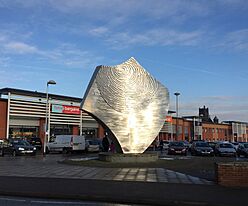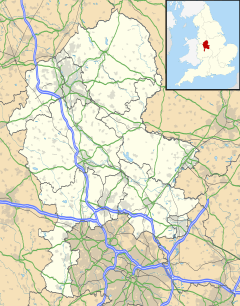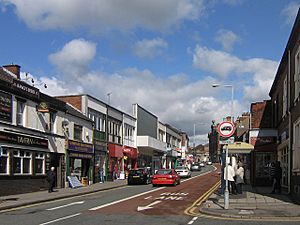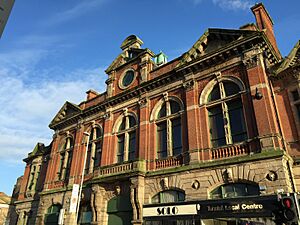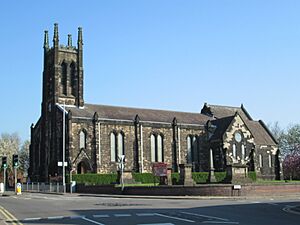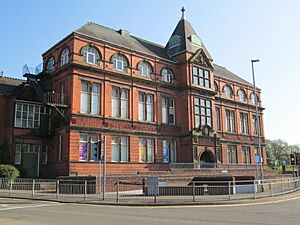Tunstall, Staffordshire facts for kids
Quick facts for kids Tunstall |
|
|---|---|
| Federated Town and District | |
|
|
| Population | 6,559 (2021 Census) |
| OS grid reference | SJ864516 |
| Unitary authority | |
| Ceremonial county | |
| Region | |
| Country | England |
| Sovereign state | United Kingdom |
| Post town | Stoke-on-Trent |
| Postcode district | ST6 |
| Dialling code | 01782 |
| Police | Staffordshire |
| Fire | Staffordshire |
| Ambulance | West Midlands |
| EU Parliament | West Midlands |
| UK Parliament |
|
Tunstall is one of the six towns that came together to form the City of Stoke-on-Trent in Staffordshire, England. It is the most northern of these towns. Tunstall is also the fourth largest town in the area known as the Potteries. It sits on a high piece of land between two brooks. The area is surrounded by old sites where tiles and bricks were made. Some of these sites have been there since the Middle Ages.
Contents
History of Tunstall
Tunstall was not mentioned separately in the old Domesday Book. People believe it was part of lands owned by Richard the forester. But Tunstall Manor quickly became very important. By the end of the 13th century, many smaller areas had joined with Tunstall Manor.
Records show that people were mining iron and coal in Tunstall as early as 1282. This was a long time ago!
The first sign of a market in Tunstall was in 1525. A market-reeve was chosen to manage it. In 1816, a market square was created. This area is now called Tower Square. Small markets started to be held there.
Tunstall was a long, narrow village for a long time. This changed during the Industrial Revolution. Now, Tunstall has many rows of Victorian houses. These were built for pottery workers when the industry grew. There are also newer housing areas. Park Terrace has beautiful old houses and is a special protected area. The houses around Victoria Park are also protected.
In 1894, Tunstall became an "urban district." This meant it could manage its own local affairs. It grew by adding nearby areas. On April 1, 1910, Tunstall joined with other towns to form Stoke-on-Trent. By 1925, Stoke-on-Trent became a city. Tunstall still has its own shopping and business area. This makes Stoke-on-Trent a city with many important centers.
On November 27, 1916, a German Zeppelin airship bombed Tunstall. It dropped three bombs while returning to Germany. The airship was shot down the next day.
Pottery in Tunstall
People have been making pottery in Tunstall since the 14th century. But for a long time, farming was more important. Coal and iron mining were also bigger industries. Tunstall was one of the last towns in the Potteries to start making pottery on a large scale. Because of this, it was not affected by the 1842 Pottery Riots.
However, Tunstall still has a rich history in pottery. At the start of the 1800s, there were only 3 pottery factories. By the end of that century, there were 13! Many famous potters worked here. These include the Adams family, Alfred Meakin, and Booths. Enoch Wedgwood and W H Grindley also had factories in Tunstall.
Clarice Cliff (1899–1972) was a very famous ceramic artist. She worked in the area from 1922 to 1963. Charles Shaw was a potter in the 1800s. His detailed life story gives us a clear look at the Victorian Potteries. It even inspired author Arnold Bennett for his novels. Tunstall became well-known for its tiles. These tiles were thought to be as good as slate. Today, decorative ceramic tiles are still made in Tunstall.
Getting Around Tunstall
Tunstall's industries used the Trent and Mersey Canal. This canal was built over 11 years starting in 1766. James Brindley designed the canal. He lived nearby in Chell.
Just north of Tunstall is one of Brindley's biggest achievements. This is the Harecastle Tunnel. The Trent and Mersey Canal goes through this tunnel under Goldenhill. In the past, men would lie on their backs in barges. They would push against the tunnel roof with their feet to move the boats. This was very hard and slow.
So, in 1827, Thomas Telford built a second, wider tunnel. This new tunnel had a path for horses to pull the barges. Today, the Harecastle Tunnels are among the longest canal tunnels in the UK.
Tunstall used to have its own railway station. It opened in 1873. But it closed in 1965. This was part of a plan to cut railway lines. Today, Tunstall is between Longport and Kidsgrove railway stations. These stations are on the line that goes from Stafford to Manchester. You can also get direct trains to Crewe and Derby.
Tunstall also has good bus services. Many bus companies connect Tunstall to all the towns around it.
The A50 is the main road through Tunstall. It goes from Warrington to Leicester. Tunstall is also connected to the A500 "D-road." This road passes west of the town. The new A527 link road connects Tunstall to the A500. This helps people get to the M6 motorway. The A34 also runs north and south nearby. It goes towards Manchester and Newcastle-under-Lyme.
Tunstall's Climate
The weather in Tunstall has mild differences between summer and winter. There is enough rain all year round. This type of weather is called a "Marine West Coast Climate."
| Climate data for Tunstall, Staffordshire | |||||||||||||
|---|---|---|---|---|---|---|---|---|---|---|---|---|---|
| Month | Jan | Feb | Mar | Apr | May | Jun | Jul | Aug | Sep | Oct | Nov | Dec | Year |
| Mean daily maximum °C (°F) | 5 (41) |
5 (41) |
8 (46) |
11 (51) |
15 (59) |
18 (64) |
20 (68) |
20 (68) |
17 (62) |
14 (57) |
9 (48) |
7 (44) |
12 (53) |
| Mean daily minimum °C (°F) | 0 (32) |
1 (33) |
2 (35) |
4 (39) |
7 (44) |
10 (50) |
11 (51) |
12 (53) |
10 (50) |
7 (44) |
4 (39) |
2 (35) |
5 (41) |
| Average precipitation cm (inches) | 5.1 (2) |
3.6 (1.4) |
4.1 (1.6) |
3.3 (1.3) |
3.6 (1.4) |
4.6 (1.8) |
4.8 (1.9) |
6.6 (2.6) |
4.8 (1.9) |
5.6 (2.2) |
6.1 (2.4) |
5.8 (2.3) |
58 (22.7) |
| Source: Weatherbase | |||||||||||||
Other Interesting Facts
In 2015, a new public art statue called Golden was put up on the edge of Tunstall. It is a 69-foot (21-meter) steel sculpture. It was paid for by private money.
The Phoenix Trust is a group that wants to make Tunstall a World Heritage Site. This is because of its important history. It played a big part in the Industrial Revolution. It was also the birthplace of Primitive Methodism, a type of Christian movement.
Tunstall has seen many new shops open recently. The Alexandra Retail Park was built with stores like Poundland and Argos. This has changed the traditional town center shops and market. In 2003–2004, the town's shops bought Christmas decorations. Now, it is a tradition to watch the Tunstall Christmas lights switch on.
A recognizable version of Tunstall, called Turnhill, appears in the novels of Arnold Bennett.
Many buildings in Tunstall are "Grade II listed." This means they are important historical buildings. Some of these include Tunstall Market Hall and Tunstall Town Hall. Also, Christ Church, the Church of the Sacred Heart, and the first Primitive Methodist chapel. The clock tower in Tower Square is also listed. So are Tunstall library and public baths. Victoria Park and its structures are also listed. The lodge and canal entrances at Harecastle Tunnel are listed too. There are also three special conservation areas. These are Tower Square, Park Terrace, and Victoria Park with its surrounding houses.
By the late 1800s, many towns in the UK had pollution and health problems. Tunstall started making improvements. The Victoria Public Baths opened in 1897. Work also began on Victoria Park, also known as Tunstall Park. The park was designed by the council's architect, Absalom Reade Wood. By 1914, the park was mostly finished. It covers 21 acres. It is now a Grade II listed park. A charity was started in 2009 to help improve the park.
The Golden Torch, on Hose Street, was a famous "Northern Soul" music club. It opened in 1965. Many famous DJs played there. After another club closed, The Torch started having "Soul All-Nighters" in 1971. But in 1973, the council did not renew its license. The club closed, and another famous club, the Wigan Casino, became popular.
The Tunstall Wakes were old festivals. They were held on the first Sunday after July 20th. The wakes were stopped in 1879 but brought back because people wanted them.
Tunstall was home to the Frink School of Figurative Sculpture for many years. This was a small art school. It was named after the British sculptor Elisabeth Frink. The school has since moved to Leek.
Today, Tunstall has many primary schools. The secondary schools include Co-op Academy Stoke-on-Trent, Ormiston Horizon Academy, and St Margaret Ward Catholic Academy.
New Developments in Tunstall
A company called Dransfield built Jasper Square. This area has stores like Poundland, Argos, and Matalan. They also built Alexandra Park next to it. This park has a health center, Boots, and a gym. The last part of this project finished in 2014. It added Home Bargains, Iceland, and Card Factory.
The park also has "The Shard." This is a stainless steel sculpture. It celebrates the area's history of pottery. Robert Erskine created it. In 2014, plans for another shopping park and a Morrisons supermarket were canceled.
The old HSBC bank on the high street was bought by new companies. It was renovated but kept its original outside look. It is now used for offices. In 2020, Gateway Psychology bought the building. This is a service for children, young people, and families. They have renovated the building, keeping many original features. It is now used for offices and therapy rooms.
Famous People from Tunstall
- William Adams (1746–1805) was a potter known for fine jasperware.
- Hugh Bourne (1772–1852) helped start Primitive Methodism.
- Jabez Vodrey (1795–1861) was the first English potter to move west of the Appalachian Mountains.
- Enoch Wedgwood (1813–1879) started the pottery company Wedgwood & Co.
- Charles Shaw (1832–1906) was a potter whose life story gave great details about the Victorian Potteries.
- William Harold Coltman (1891–1974) was a highly decorated British soldier. He received the Victoria Cross.
- Clarice Cliff (1899–1972) was a very famous ceramic artist born in Tunstall.
- Susie Cooper (1902–1995) was a ceramic artist and designer.
- Leslie Hulme, known as Ken Barrie (1933–2016), was the voice of Postman Pat.
- Robbie Williams (born 1974) is a famous pop star. He grew up in Tunstall.
- Martin Paterson (born 1987) is a professional footballer. He was born in Tunstall.


